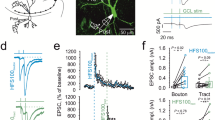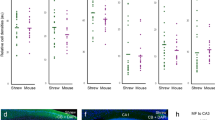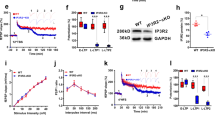Abstract
LONG-TERM potentiation (LTP) and long-term depression (LTD) are activity-dependent changes in synaptic strength that may serve as the cellular mechanisms of information storage in the vertebrate brain1–4. The mossy fibre–CA3 synapse displays NMDA (N-methyl-D-aspartate) receptor-independent forms of LTP5–8 and LTD9–11 that were thought to be non-associative9–11. Here we report that the mossy fibre–CA3 synapse displays each of the known types of LTD in vivo, including associative, heterosynaptic and homosynaptic LTD. These types of LTD are induced when only two of the three conditions necessary for mossy fibre LTP induction are provided. Because some of these conditions can be provided by convergent CA3 afferents, each type of LTD can be induced in an associative manner, which suggests that LTD is involved in associative information storage. Similar to the induction of NMDA receptor-dependent LTD and LTP at other cortical synapses, mossy fibre LTD occurs when synaptic conditions are insufficient to induce LTP, and both LTP and LTD induction are influenced by previous synaptic activity, consistent with the view that common principles govern activity-dependent plasticity at cortical synapses2,12,22.
This is a preview of subscription content, access via your institution
Access options
Subscribe to this journal
Receive 51 print issues and online access
$199.00 per year
only $3.90 per issue
Buy this article
- Purchase on Springer Link
- Instant access to full article PDF
Prices may be subject to local taxes which are calculated during checkout
Similar content being viewed by others
References
Bliss, T. V. P. & Collingridge, G. L. Nature 361, 31–39 (1993).
Artola, A. & Singer, W. Trends Neurosci. 16, 480–487 (1993).
Linden, D. Neuron 12, 457–472 (1994).
Martinez, J. L. Jr & Derrick, B. E. A. Rev. Psychol. 47, 173–203 (1995).
Harris, E. W. & Cotman, C. W. Neurosci. Lett. 70, 132–137 (1986).
Zalutsky, R. A. & Nicoll, R. A. Science 248, 1619–1624 (1990).
Derrick, B. E. & Martinez, J. L. Jr J. Neurosci. 14, 4359–4367 (1994).
Williams, S. & Johnston, D. Neuron 3, 583–588 (1989).
Weisskopf, M., Zalutsky, R. A. & Nicoll, R. A. Nature 362, 423–427 (1993).
Chatterji, S., Stanton, P. & Sejnowski, T. J. Brain Res. 495, 145–150 (1989).
Bradler, J. E. & Barrionuevo, G. Neuroscience 35, 265–271 (1990).
Bienenstock, E. L., Cooper, L. B. & Munro, P. W. J. Neurosci. 2, 32–48 (1982).
Derrick, B. E. & Martinez, J. L. Jr Proc. natn. Acad. Sci. U.S.A. 91, 10290–10294 (1994).
Wagner, J. J., Caudle, R. M., Neumaier, J. F. & Chavkin, C. Neuroscience 37, 45–53 (1990).
Caudle, R. M., Wagner, J. J. & Chavkin, C. J. Pharmac. exp. Ther. 258, 18–26 (1991).
Drake, C. T. et al. J. Neurosci. 14, 3736–3750 (1994).
Montague, P. R. & Sejnowski, T. J. Learn. Memory 1, 1–33 (1994).
White, G., Levy, W. B. & Steward, O. J. Neurosci. 64, 1186–1198 (1990).
Dudek, S. M. & Bear, M. F. Proc. natn. Acad. Sci. U.S.A. 89, 4363–4367 (1992).
Derrick, B. E., Rodriguez, S. B., Lieberman, D. N. & Martinez, J. L. Jr J. Pharmac. exp. Ther. 263, 725–733 (1992).
Mulkey, R. M. & Malenka, R. C. Neuron 9, 967–975 (1992).
Intrator, N., Bear, M. F., Cooper, L. N. & Paradiso, M. A. In Synaptic Plasticity: Molecular, Cellular, and Functional Aspects (eds Baudry, M., Thompson, R. F. & Davis, J. L.) 147–168 (MIT Press, Cambridge, MA, 1993).
Mayford, M., Wang, J., Kandel, E. R. & O'Dell, T. J. Cell 81, 891–904 (1995).
Huang, Y.-Y., Colino, A., Selig, D. K. & Malenka, R. C. Science 255, 730–733 (1992).
Sejnowski, T. J. J. math. Biol. 4, 303–321 (1977).
Willshaw, D. & Dayan, P. Neural Comp. 2, 85–93 (1990).
Reiter, H. O. & Stryker, M. P. Proc. natn. Acad. Sci. U.S.A. 85, 3623–27 (1988).
Law, C. C. & Cooper, L. N. Proc. natn. Acad. Sci. U.S.A. 91, 7797–7801 (1994).
Kirkwood, A., Dudek, S. M., Gold, J. T., Aizenman, C. D. & Bear, M. F. Science 260, 1518–1521 (1993).
Author information
Authors and Affiliations
Rights and permissions
About this article
Cite this article
Derrick, B., Martinez, J. Associative, bidirectional modifications at the hippocampal mossy fibre–CA3 synapse. Nature 381, 429–434 (1996). https://doi.org/10.1038/381429a0
Received:
Accepted:
Issue Date:
DOI: https://doi.org/10.1038/381429a0
This article is cited by
-
Studies of the Synaptic Plasticity of Field CA3 of the Hippocampus During Tetanization of the Perforant Path
Neuroscience and Behavioral Physiology (2005)
-
Selective involvement of opioids in the mechanisms of synapse-specific plasticity in the common snail during the acquisition of sensitization
Neuroscience and Behavioral Physiology (2005)
Comments
By submitting a comment you agree to abide by our Terms and Community Guidelines. If you find something abusive or that does not comply with our terms or guidelines please flag it as inappropriate.



